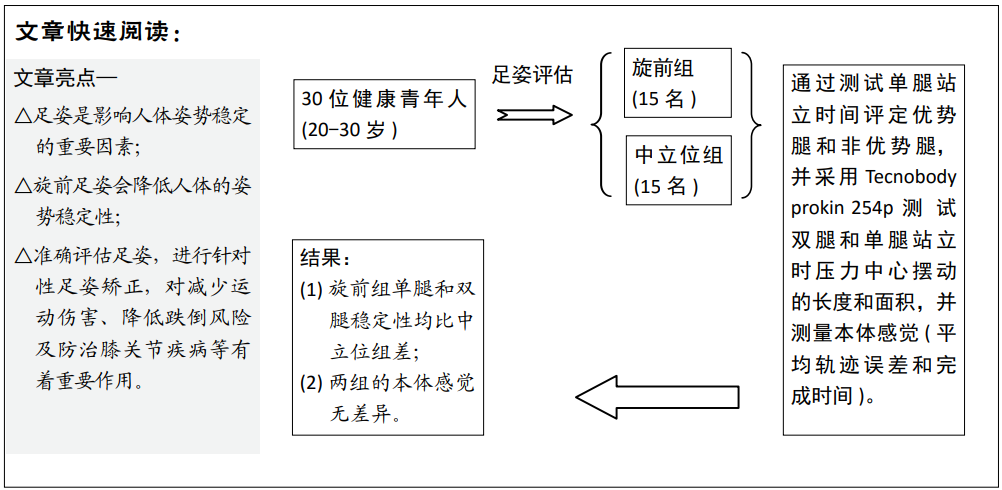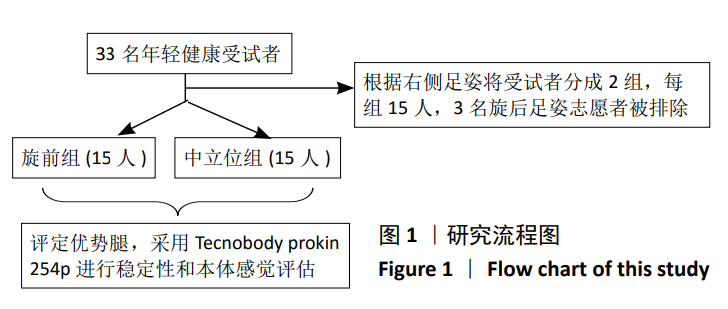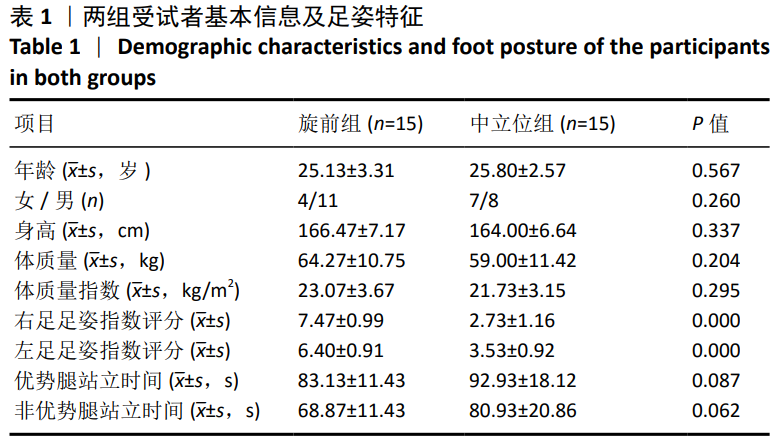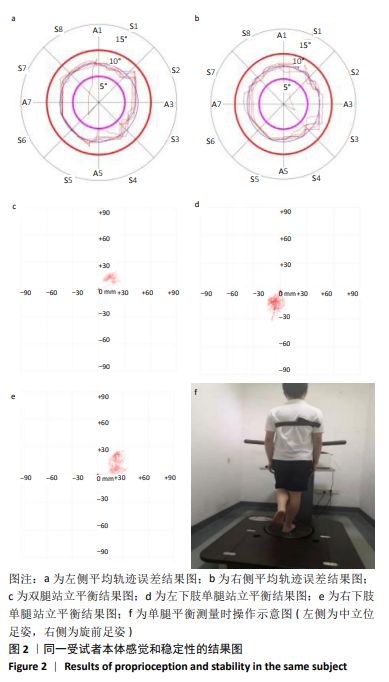[1] TINETTI ME, SPEECHLEY M, GINTER SF. Risk factors for falls among elderly persons living in the community.N Engl J Med.1988;319(26):1701-1707.
[2] 张新语,霍洪峰.足姿指数(FPI):足部姿势及足踝功能的定量表达[J].中国矫形外科杂志,2019,27(13):1194-1199.
[3] REDMOND AC, CROSBIE J,OUVRIER RA.Development and validation of a novel rating system for scoring standing foot posture: the foot posture index. Clin Biomech. 2006;21(1):89-98.
[4] AQUINO MRC, AVELAR BS, SILVA PL, et al. Reliability of Foot Posture Index individual and total scores for adults and older adults.Musculoskelet Sci Pract. 2018;36:92-95.
[5] EVANS AM, COPPER AW, SCHARFBILLIG RW, et al. Reliability of the foot posture index and traditional measures of foot position.J Am Podiatr Med Assoc. 2003;93(3):203-213.
[6] GIJON-NOGUERON G, MARCHENA‐RODRIGUEZ A, MONTES‐ALGUACIL J, et al. Evaluation of the paediatric foot using footprints and foot posture index: A cross‐sectional study.J Paediatr Child Health.2020;56(2):201-206.
[7] REDMOND A. The Foot Posture Index. User guide and manual [Manual available online]. Leeds: University of Leeds,2015.
[8] MOTANTASUT P, HUNSAWONG T, MATO L, et al. Reliability of novice and experienced physiotherapists using the normalized navicular height truncated and the foot posture index-6 for classifying static foot posture in adults. J Phys Ther Sci. 2019;31(4):392-397.
[9] ANGıN S, ILÇIN N, YEŞILYAPRAK SS, et al. Prediction of postural sway velocity by foot posture index, foot size and plantar pressure values in unilateral stance. Eklem Hastalik Cerrahisi. 2013;24(3):144-148.
[10] BULDT AK, FORGHANY S, LANDORF KB, et al. Foot posture is associated with plantar pressure during gait: A comparison of normal, planus and cavus feet.Gait Posture. 2018;62:235-240.
[11] RESENDE RA, KIRKWOOD RN, DELUZIO KJ, et al. Ipsilateral and contralateral foot pronation affect lower limb and trunk biomechanics of individuals with knee osteoarthritis during gait.Clin Biomech (Bristol, Avon).2016;34:30-37.
[12] OHI H, IIJIMA H, AOYAMA T, et al. Association of frontal plane knee alignment with foot posture in patients with medial knee osteoarthritis.BMC Musculoskelet Disord.2017;18(1):246.
[13] PÉREZ-MORCILLO A, GÓMEZ-BERNAL A, GIL-GUILLEN VF, et al. Association between the Foot Posture Index and running related injuries: A case-control study. Clin Biomech (Bristol, Avon).2019;61:217-221.
[14] HENRY M. Age-related changes in leg proprioception: implications for postural control.J Neurophysiol. 2019;122(2):525-538.
[15] HASSAN BS, MOCKETT S, DOHERTY M. Static postural sway, proprioception, and aximal voluntary quadriceps contraction in patients with knee osteoarthritis and normal control subjects.Ann Rheum Dis. 2001;60(6):612-618.
[16] COTE KP, BRUNET ME, GANSNEDER BM, et al. Effects of Pronated and Supinated Foot Postures on Static and Dynamic Postural Stability.J Athl Train. 2005;40(1):41-46.
[17] PAILLARD T, NOÉ F. Techniques and Methods for Testing the Postural Function in Healthy and Pathological Subjects. Biomed Res Int. 2015;2015:891390.
[18] PINSAULT N, VUILLERME N. Test-retest reliability of centre of foot pressure measures to assess postural control during unperturbed stance. Med Eng Phys. 2009;31:276-286.
[19] SHARMA L. Proprioceptive impairment in knee osteoarthritis.Rheum Dis Clin North Am. 1999;25(2):299.
[20] KNIGHT AC, HOLMES ME, CHANDER H, et al. Assessment of balance among adolescent track and field athletes.Sports Biomech.2016;15(2):169-179.
[21] PROMSRI A, HAID T, FEDEROLF P. How does lower limb dominance influence postural control movements during single leg stance? Hum Mov Sci.2018;58:165-174.
[22] LANSHAMMAR K, RIBOM EL. Differences in muscle strength in dominant and non-dominant leg in females aged 20-39 years–A population-based study.Phys Ther Sport.2011;12(2):76-79.
[23] CINAR-MEDENI O, BALTACI G, BAYRAMLAR K, et al. Core stability, knee muscle strength, and anterior translation are correlated with postural stability in anterior cruciate ligament-reconstructed patients.Am J Phys Med Rehabil.2015; 94(4):280-287.
[24] ALONSO AC, BRECH GC, BOURQUIN AM, et al. The influence of lower-limb dominance on postural balance.Sao Paulo Med J.2011;129(6):410-413.
[25] HOFFMAN M, SCHRADER J, APPLEGATE T, et al. Unilateral postural control of the functionally dominant and nondominant extremities of healthy subjects.J Athl Train.1998;33(4):319-322.
[26] 陈泽华,叶翔凌,陈伟健,等.健康成年人下肢本体感觉与姿势稳定性的关系[J].中国组织工程研究,2020,24(29):4692-4696.
[27] BARONE R, MACALUSO F, TRAINA M, et al. Soccer players have a better standing balance in nondominant one-legged stance.Open Access J Sports Med.2010;2:1-6.
[28] 张英媛,王国栋,陆阿明.下肢优势侧评定方法的比较研究[J].北京体育大学学报, 2014,37(10):83-88.
[29] ROSS SE, GUSKIEWICZ KM. Examination of static and dynamic postural stability in individuals with functionally stable and unstable ankles.Clin J Sport Med. 2004;14(6):332-338.
[30] PROSKE U, GANDEVIA SC. The proprioceptive senses: their roles in signaling body shape, body position and movement, and muscle force.Physiol Rev.2012;92(4): 1651-1697.
[31] KHARAJI G, NIKJOOY A, AMIRI A, et al.Proprioception in stress urinary incontinence: A narrative review.Med J Islam Repub Iran.2019;33:60.
[32] AREIA C,BARREIRA P,MONTANHA T,et al.Neuromuscular changes in football players with previous hamstring injury.Clin Biomech (Bristol,Avon). 2019;69:115-119.
[33] MEI Q, GU Y, XIANG L, et al. Foot Pronation Contributes to Altered Lower Extremity Loading After Long Distance Running.Front Physiol.2019;10:573.
[34] COBB SC, BAZETT-JONES DM, JOSHI MN, et al. The relationship among foot posture, core and lower extremity muscle function, and postural stability.J Athl Train. 2014;49(2):173-180.
[35] ZHANG X, SCHÜTTE KH, VANWANSEELE B. Foot muscle morphology is related to center of pressure sway and control mechanisms during single-leg standing.Gait Posture. 2017;57:52-56.
[36] BONIFÁCIO D, RICHARDS J, SELFE J, et al. Influence and benefits of foot orthoses on kinematics, kinetics and muscle activation during step descent task.Gait Posture.2018;65:106-111.
[37] ROBBINS S, WAKED E, MCCLARAN J. Proprioception and stability: foot position awareness as a function of age and footwear.Age Ageing. 1995;24(1):67-72.
[38] VIRMANI T, GUPTA H, SHAH J, et al. Objective measures of gait and balance in healthy non-falling adults as a function of age.Gait Posture. 2018; 65:100-105.
[39] KO SU, SIMONSICK EM, DESHPANDE N, et al. Ankle Proprioception-Associated Gait Patterns in Older Adults: Results from the Baltimore Longitudinal Study of Aging.Med Sci Sports Exerc.2016;48(11):2190-2194.
[40] 朱世杰,王文婷,章露.足部姿态变化对静态姿势稳定控制的即刻作用[J].中国组织工程研究,2012,16(37):6910-6915.
[41] TAN JM, MIDDLETON KJ, HART HF, et al. Immediate effects of foot orthoses on lower limb biomechanics, pain, and confidence in individuals with patellofemoral osteoarthritis.Gait Posture.2020;76:51-57. |






